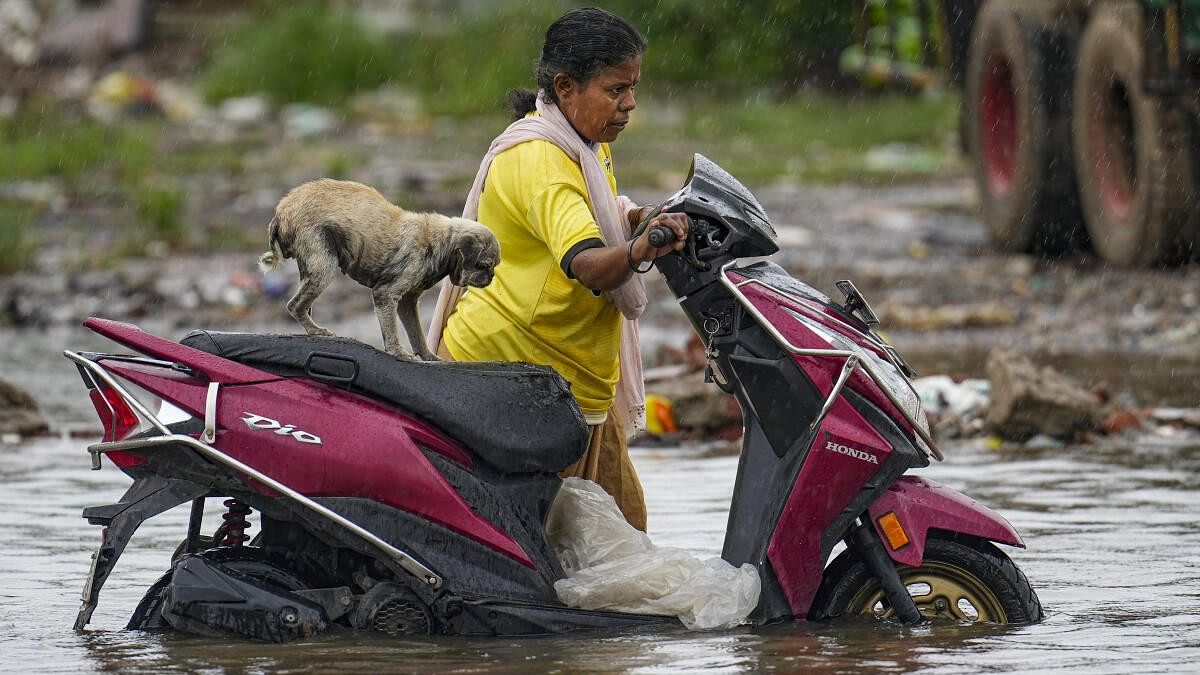
A woman drags a scooty with a puppy sitting on it on a waterlogged road amid rains, in Chennai.
Credit: PTI photo
Chennai: Tamil Nadu’s lifeline, North-east Monsoon (NEM), is likely to be a period of “non-stop disturbances” as it is expected to dump huge amounts of rainfall, according to predictions by independent weather bloggers, who also say the monsoon could peak in November.
The weather bloggers, who have a huge following on social media with their predictions coming true often, point to the recent rains that lashed Chennai and its neighbouring districts where some localities recorded a whooping 30 cm rainfall in just 24 hours to buttress their point that the NEM in 2024 could become an year of excess rains.
The rainfall recorded in just a couple of days across Tamil Nadu has accounted for 80 per cent of the average rainfall received in October. The state has been a witness to such extreme weather events in 2023 as well with unprecedented rainfall lashing three different parts of Tamil Nadu – Nilgiris, Chennai, and Thoothukudi – in just about a month.
NEM is the chief rainy season for Chennai with over 48 per cent (442.8 mm) of its annual rainfall being realised during this season (October-December).
“High intense rainfall in less duration is going to be the order of the day as we witness an increase in the number of extreme weather events. While the number of hot days are increasing, the number of rainy days are on the decline. The average rainfall is also increasing,” Prabhakaran Veeraarasu, Environment Scientist, Poovulagin Nanbargal, told DH.
Once in a 100-year or 50-year events would now occur once in five years or once in ten years, Veeraarasu said, adding that cyclones have also become a regular affair far from being “rare events”, which was the case just about a decade ago.
K Srikanth, a weather blogger, said the onset of NEM 2024 was “strong” under the influence of a Depression in the Bay of Bengal though the system weakened significantly before making the landfall.
“The interplay dynamics between multiple circulations recently is an indicator of the season ahead of us. This monsoon will be a season of nonstop disturbances. November could be a month full of disturbances due to the weather system. We can expect back-to-back systems bringing enough rain,” Srikanth told DH.
He said Chennai and the rest of Tamil Nadu can expect regular rains for the next few days during the night and early morning hours. “Most of the pulses are imported from the South China sea. Going by the models, the impact for Tamil Nadu will be high. It is not that all weather events will be extreme but the number of events will possibly increase,” Srikanth added.
Dr Kirthiga Murugesan, research scholar at IIT-Madras, said the “above average rainfall” prediction has been arrived at by weather bloggers by looking at the past data and future seasonal scale climate models for three to six months.
“We are getting into the La Nina phase and weather bloggers are trying to relate the pattern by analysing the past data. If one goes by their analysis, there is certainly a likelihood of above average rainfall. The monsoon is likely to be intense,” she told DH.
Veeraarasu said the government should go beyond constructing storm water drains whose utility is restricted to certain area to contain floods in a coastal city like Chennai.
“We can keep deploying pumps to drain water out of localities. At the maximum, construction of storm water drains can only be a short measure, while the mid-term measure could be to do a comparative analysis of recent flood events and the areas affected by it to come up with location-specific solutions,” he said.
The long-term solution, according to him, is removing encroachments by government and private individuals along water bodies and in marshlands like Pallikaranai in Chennai. “Without removing the encroachments in Pallikaranai marshland, flooding in south Chennai can never be prevented,” he added.